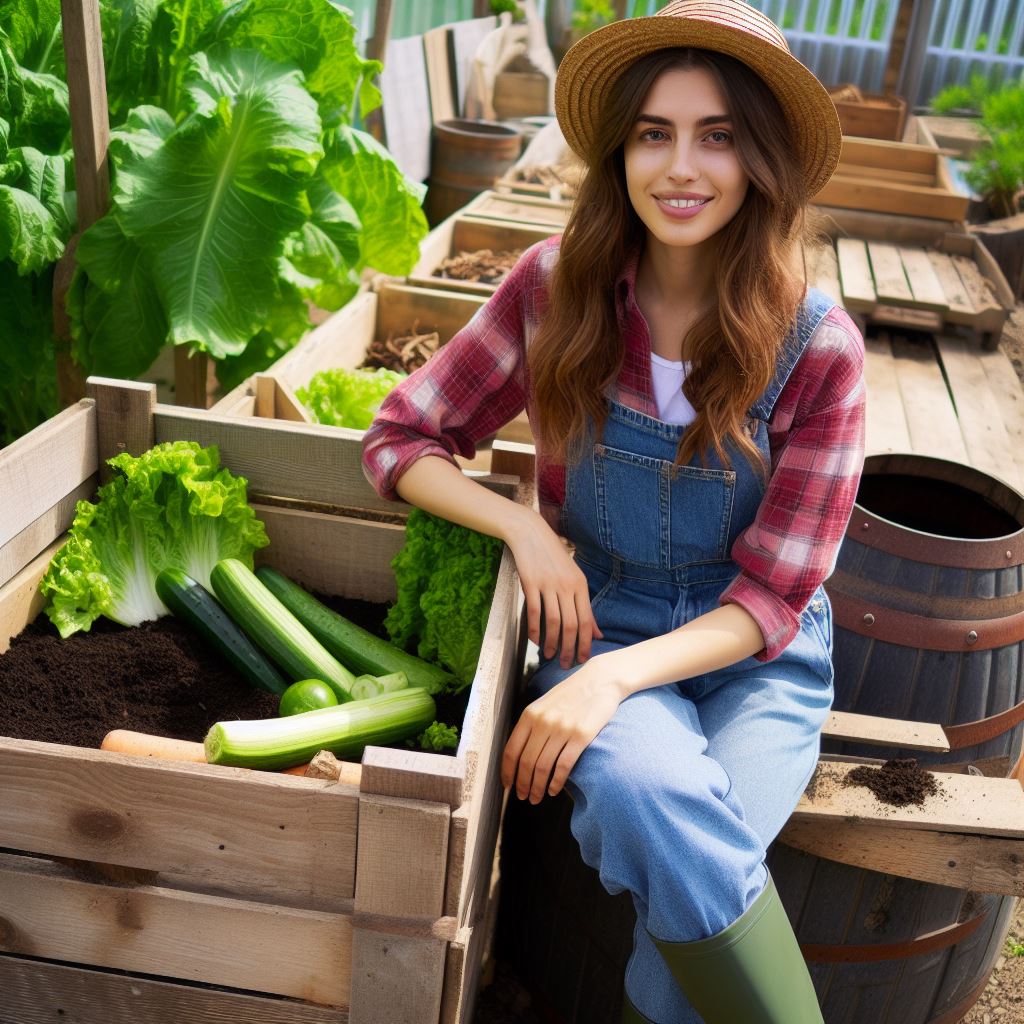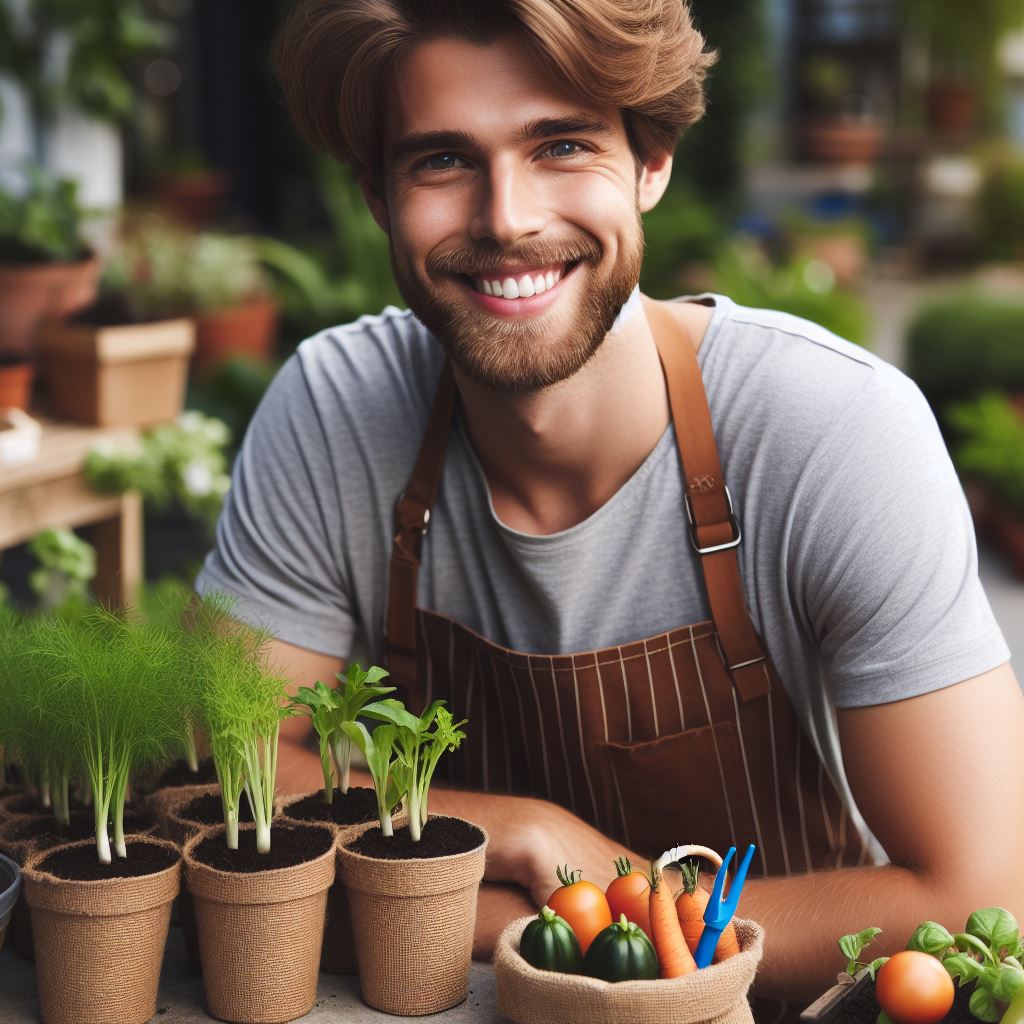Introduction
Urban farming, defined as the cultivation of crops or the raising of animals within urban areas, represents a creative solution to the challenges of food production in densely populated environments.
In recent years, urban farming has experienced a surge in popularity driven by various factors such as increasing awareness of food sustainability issues, concerns about the environmental impact of conventional agriculture, and a growing desire for fresh, locally sourced produce.
Maximizing small spaces for urban farming is essential for several reasons.
Firstly, with the rapid pace of urbanization, available land for traditional agriculture is shrinking, making it necessary to utilize every inch of available space efficiently.
Secondly, by growing food in urban areas, it reduces the carbon footprint associated with transporting produce from rural farms to urban markets.
Finally, urban farming can help address issues of food insecurity by providing fresh, nutritious food in areas where access to such food is limited.
Overall, the importance of maximizing small spaces for urban farming cannot be overstated.
By utilizing innovative techniques such as vertical gardening, rooftop farming, and hydroponics, urban farmers can make the most of limited space to produce a significant amount of food.
In the following sections, we will explore various strategies and tips for maximizing small spaces for urban farming, from selecting the right crops to optimizing growing conditions and utilizing space-saving techniques.
Benefits of Urban Farming
A. Access to fresh, organic produce
Urban farming allows individuals to have direct access to fresh and organic produce, right at their doorstep.
By growing their own fruits, vegetables, and herbs, they can ensure that what they consume is free from harmful pesticides and chemicals.
This not only promotes healthier eating habits but also supports sustainable and environmentally-friendly practices.
B. Reduction of carbon footprint
Urban farming contributes to reducing the carbon footprint by reducing the need for transportation and refrigeration of produce.
By growing food locally, the distance it travels from farm to plate is greatly reduced, resulting in lower emissions and energy consumption.
It also decreases the reliance on large-scale industrial agriculture, known for its high carbon emissions and negative environmental impact.
C. Promotion of local food security
Engaging in urban farming promotes local food security by ensuring a constant supply of fresh produce within the community.
In times of food crises or disruptions in the food supply chain, urban farms can act as a reliable source of sustenance.
By growing food locally, communities are less dependent on external sources, making them more resilient and self-sufficient.
D. Engaging community involvement
Urban farming fosters community involvement and social cohesion by creating shared spaces for individuals to come together.
It provides opportunities for collaboration, shared learning, and the exchange of knowledge and resources.
Transform Your Agribusiness
Unlock your farm's potential with expert advice tailored to your needs. Get actionable steps that drive real results.
Get StartedCommunal gardens and urban farms become meeting points where people from diverse backgrounds can interact and bond over a common interest in food production.
E. Opportunity for physical activity and mental well-being
Engaging in urban farming offers an opportunity to incorporate physical activity into daily routines.
Tending to the plants, maintaining the garden, and harvesting crops involve physical exertion, promoting a healthier and more active lifestyle.
Moreover, gardening has been shown to have mental health benefits, reducing stress, anxiety, and depression.
Being surrounded by green spaces and connecting with nature can improve overall well-being and quality of life.
Overall, urban farming brings a myriad of benefits to both individuals and communities.
It offers access to fresh, organic produce, reduces carbon footprint, promotes local food security, fosters community involvement, and enhances physical activity and mental well-being.
By embracing urban farming, individuals can make a positive impact on their health, environment, and community.
Assessing Your Space
In order to maximize your small space for urban farming, it is important to assess your available square footage, consider sunlight exposure and access to water, identify suitable areas for farming, and creatively use vertical space.
A. Evaluating available square footage
- Measure the total area of your space to determine how much room you have for farming.
- Take into account any obstacles or obstructions that might limit usable space.
- Consider vertical space as well, such as walls or fences, to expand your farming area.
B. Considering sunlight exposure and access to water
- Observe the amount of sunlight your space receives throughout the day.
- Identify areas with the most sunlight for sun-loving plants.
- Ensure easy access to a water source for irrigation and plant maintenance.
C. Identifying suitable areas for farming
- Look for flat, level surfaces where you can place containers or create raised beds.
- Consider the stability of the ground and potential drainage issues.
- Take note of existing planters, pots, or structures that could be repurposed for farming.
D. Creative use of vertical space
- Utilize vertical gardening techniques such as installing trellises, hanging baskets, or wall-mounted planters.
- Grow vine plants that climb and utilize the vertical surface area.
- Consider utilizing balcony railings, fences, or existing structures for vertical farming.
By thoroughly assessing your small space, you can make the most of every square foot and create an efficient urban farming setup.
Choosing Crops for Small Spaces
A. Varieties of vegetables and fruits suitable for urban farming
When it comes to urban farming and maximizing small spaces, choosing the right crops is crucial.
By selecting vegetables and fruits that are suitable for urban environments, you can ensure a successful and bountiful harvest.
1. Tomatoes
- Cherry tomatoes are perfect for small spaces as they can be grown in containers or hanging baskets.
- Determinate varieties, like Patio or Bush tomatoes, have compact growth habits and are ideal for limited spaces.
2. Peppers
- Dwarf pepper varieties, such as Mini Bell or Lunchbox, are well-suited for small gardens or containers.
- Banana peppers or Padrón peppers are also excellent options due to their compact size and high yields.
3. Cucumbers
- Bush cucumber varieties, like Salad Bush or Bush Pickle, are perfect for small gardens and containers.
- You can also try growing cucumbers vertically using trellises or tomato cages, maximizing your vertical space.
4. Strawberries
- Everbearing or alpine strawberry varieties are great for compact spaces.
- They can be grown in pots or hanging baskets, allowing you to enjoy delicious fresh strawberries even in small areas.
B. Herbs and microgreens that thrive in small spaces
Herbs and microgreens are excellent choices for urban farming, as they can be grown indoors or in small outdoor areas.
Here are some options to consider:
1. Basil
- Compact varieties like Spicy Globe or Bush Basil are ideal for small gardens or containers.
- Pinching the tips regularly encourages bushier growth and more abundant harvests.
2. Chives
- Garlic chives or the more common onion chives are perfect for small spaces.
- They can be grown in pots or window boxes, and their leaves can be harvested as needed.
3. Salad Greens
- Lettuce varieties such as Mesclun Mix or Butterhead lettuces do well in small spaces.
- These can be grown in shallow containers or raised beds and provide a continuous supply of fresh salad greens.
- Microgreens:
- Microgreens like arugula, radish, or broccoli can be grown in trays or shallow containers.
- They require minimal space, grow quickly, and are packed with nutrients, making them a popular choice for urban farmers.
C. Incorporating edible flowers and ornamental plants
In addition to vegetables and herbs, incorporating edible flowers and ornamental plants can add beauty and variety to your urban farming experience.
Consider the following options:
1. Nasturtiums
- Nasturtium flowers not only add vibrant colors but also have a peppery flavor that can enhance salads.
- They can be grown in containers or even in hanging baskets, cascading down and adding visual appeal.
2. Marigolds
- Marigold flowers are not only pretty but also attract beneficial insects to the garden.
- They can be used as edible garnishes or brewed into teas to provide a unique flavor.
3. Pansies
- Pansy flowers come in a variety of colors and can be used to decorate cakes, salads, or desserts.
- They thrive in containers and make a charming addition to any urban garden.
By carefully selecting crops for small spaces, you can turn your urban farming venture into a flourishing success.
Remember to choose varieties that are suitable for your specific environment and fulfill your gardening goals.
With the right choices, even the tiniest spaces can become productive and vibrant urban farms.
Container Gardening
In this section, we will explore the world of container gardening and how it can transform your small space into a thriving urban farm.
Container gardening is an excellent way to maximize the potential of limited areas, allowing you to grow a variety of plants and vegetables without the need for large plots of land or traditional gardens.
A. Overview of container gardening
Container gardening involves growing plants in containers or pots instead of planting them directly in the ground.
It offers numerous benefits, including portability, easy maintenance, and the ability to control growing conditions.
- Allows gardening in small spaces like balconies, windowsills, or rooftops.
- Offers flexibility, as containers can be moved to optimize sunlight and temperature.
- Reduces the risk of soil-borne pests and diseases.
- Provides easy access for gardeners with physical limitations.
B. Selecting suitable containers and soil
The choice of containers and soil plays a crucial role in the success of your container garden.
Here are some key considerations:
- Choose containers that are the right size and material for your plants.
- Ensure containers have drainage holes to prevent waterlogging.
- Use nutrient-rich potting soil specifically formulated for container gardening.
- Consider using self-watering containers to maintain proper moisture levels.
C. Proper watering and drainage techniques
Watering and drainage are essential for maintaining healthy container plants.
Follow these guidelines:
- Water plants thoroughly but avoid overwatering, as it can lead to root rot.
- Check moisture levels regularly by sticking your finger into the soil.
- Ensure containers have proper drainage to prevent waterlogging.
- Consider using a saucer or tray underneath containers to catch excess water.
D. Understanding the role of fertilizer and nutrients
Fertilizer and nutrients are vital for the growth and productivity of container plants.
Here are some factors to keep in mind:
- Choose a balanced fertilizer specifically formulated for container plants.
- Follow the recommended dosage and application frequency provided by the manufacturer.
- Consider using organic fertilizers to promote healthy and sustainable growth.
- Regularly monitor nutrient deficiencies and adjust fertilization accordingly.
By implementing these strategies, you can create a thriving container garden in your small space and enjoy the benefits of urban farming.
Container gardening offers endless possibilities for growing a wide array of plants, from herbs and flowers to vegetables and fruits.
With careful planning and maintenance, you can transform your small space into an urban oasis.
Read: Urban Farm Water-Saving: Top 5 Effective Methods
Vertical Gardening
A. Benefits of vertical gardening
- Maximizes small space by utilizing vertical surfaces.
- Provides more growing area for plants in limited urban spaces.
- Reduces strain on the back and knees as gardening can be done at a comfortable height.
- Improves air circulation and sunlight exposure for plants, resulting in better growth.
- Enhances the aesthetic appeal of urban spaces, adding greenery to walls and fences.
B. Different types of vertical gardening systems
- Vertical hydroponic systems: Utilizes nutrient-rich water to grow plants without soil.
- Vertical aeroponic systems: Uses mist or air to deliver nutrients to plant roots.
- Vertical tower gardens: Consist of stacked containers or pots for growing plants vertically.
- Vertical pallet gardens: Utilizes repurposed wooden pallets with plant slots for vertical cultivation.
- Vertical pocket systems: Have pockets or pouches to hold plants on a vertical fabric structure.
C. Growing plants vertically using trellises, hanging baskets, or towers
To maximize your small space, you can utilize trellises, hanging baskets, or towers specifically designed for vertical gardening.
- Trellises: Provide support for climbing plants, allowing them to grow vertically and save space.
- Hanging baskets: Suspended from ceilings or walls, they can hold various plants for vertical cultivation.
- Towers: Vertical structures with multiple planting pockets, ideal for growing herbs and small vegetables.
D. Techniques for maintaining vertical gardens
- Regular watering: Ensure plants receive adequate moisture, especially those higher up.
- Proper pruning: Remove dead leaves and stems to maintain a healthy and tidy appearance.
- Support structures: Regularly check and reinforce trellises, hanging baskets, or towers.
- Fertilization: Provide plants with necessary nutrients to promote healthy growth.
- Regular inspections: Monitor for pests or diseases and take necessary preventive measures.
- Rotation: Periodically change plant positions to evenly distribute sunlight and prevent overcrowding.
- Maintaining soil quality: Add compost or organic matter to ensure nutrient-rich soil.
- Harvesting: Regularly harvest mature produce to encourage continuous growth.
Vertical gardening is an excellent solution for urban dwellers with limited space.
By taking advantage of vertical surfaces and utilizing various systems like trellises, hanging baskets, or towers, you can grow a wide variety of plants.
The benefits include maximizing space, improving air circulation, and enhancing the overall aesthetic appeal.
Maintaining vertical gardens involves regular watering, pruning, and inspections to ensure healthy growth.
With these techniques, even the smallest urban area can become a flourishing green space.
Read: Fall Harvest Guide: Best Practices

Indoor Farming Techniques
Indoor farming has revolutionized the way we grow plants, allowing individuals with limited space to enjoy the benefits of gardening.
Various techniques, such as hydroponics, aquaponics, aeroponics, and advanced indoor climate control, have enabled unprecedented growth in urban agriculture.
Showcase Your Farming Business
Publish your professional farming services profile on our blog for a one-time fee of $200 and reach a dedicated audience of farmers and agribusiness owners.
Publish Your ProfileA. Hydroponics: growing plants without soil
One of the most popular indoor farming techniques is hydroponics, which involves growing plants without soil.
Instead of relying on the ground for nutrition, plants receive essential nutrients through a water-based solution.
By using this method, you can maximize your small space and grow an array of crops indoors.
B. Aquaponics: combining fish farming and hydroponics
Aquaponics is another innovative method that combines fish farming with hydroponics.
In this system, fish waste acts as a natural fertilizer for the plants, while the plants filter the water for the fish.
It creates a symbiotic relationship that benefits both the fish and plants.
This technique is not only efficient but also allows you to harvest both fish and vegetables.
C. Aeroponics: growing plants in a mist or air environment
If you’re looking for a more advanced and efficient indoor farming technique, consider aeroponics.
Aeroponics involves growing plants in a mist or air environment.
The roots are suspended in air, and they are periodically sprayed with a nutrient-rich solution.
This method provides optimal oxygenation to the roots, promoting faster and healthier plant growth.
D. Utilizing grow lights and controlling indoor climate
To ensure successful indoor farming, it’s crucial to utilize grow lights and control the indoor climate.
Since natural sunlight may not be sufficient indoors, using artificial grow lights that mimic the sun’s spectrum is essential.
By providing the correct light spectrum and intensity, you can promote proper photosynthesis and maximize plant growth.
Controlling the indoor climate is equally important.
Regulating temperature, humidity, and airflow ensures optimal growing conditions for your plants.
It’s essential to monitor and adjust these factors as different plants have varying requirements.
By creating a favorable environment, you can mimic outdoor conditions and cultivate healthy, thriving plants.
In addition to these techniques, various technologies and tools are available to simplify indoor farming.
Automated systems can control irrigation, nutrient delivery, and climate settings, taking much of the guesswork out of the process.
Smart sensors can monitor plant health and alert you to any issues, allowing for prompt intervention.
Indoor farming presents endless possibilities for urban dwellers and those with limited gardening space.
By embracing hydroponics, aquaponics, aeroponics, and utilizing grow lights while controlling the indoor climate, you can create a mini-farm right in your own home.
Explore these indoor farming techniques and start maximizing your small space today.
Read: Summer Garden Care: Beat the Heat!
Pest Control and Disease Prevention
In order to have a successful urban farm, it is crucial to have effective pest control and disease prevention strategies in place.
This section will explore the common pests and diseases found in urban farming, as well as organic pest control methods and preventative measures for disease prevention.
A. Understanding common pests and diseases in urban farming
- Aphids: These tiny insects can quickly multiply and damage plants by sucking the sap.
- Whiteflies: They feed on plant sap and excrete a sticky substance that attracts mold.
- Caterpillars: These larvae can eat through leaves, causing extensive damage to crops.
- Spider mites: They are known for webbing and sucking the plant sap, leading to yellowing leaves.
- Plant diseases: Common urban farming diseases include powdery mildew, blight, and leaf spot.
By understanding these common pests and diseases, farmers can take proactive measures to prevent infestations and diseases from spreading.
B. Implementing organic pest control methods
Organic pest control methods are essential for urban farming as they minimize the use of harmful chemicals.
Some effective methods include:
- Biological control: Introduce beneficial insects like ladybugs and lacewings to eat harmful pests.
- Companion planting: Planting certain crops together can deter pests or attract beneficial insects.
- Physical barriers: Use row covers, netting, or fences to physically prevent pests from reaching the plants.
- Natural sprays and repellents: Homemade sprays made from garlic, neem oil, or soap can repel pests.
Implementing these organic pest control methods will help maintain a healthy and pest-free urban farm.
C. Maintaining good hygiene and sanitation practices
Proper hygiene and sanitation practices are vital to prevent the spread of pests and diseases.
It includes:
- Regularly removing weeds and decaying plant matter where pests and diseases can thrive.
- Cleaning tools and equipment to avoid cross-contamination between plants.
- Implementing crop rotation to prevent the build-up of pests and diseases in the soil.
- Disposing of infected or pest-infested plants appropriately to prevent further spread.
By maintaining good hygiene and sanitation practices, urban farmers can create a healthy environment for their crops.
D. Preventative measures for disease prevention
Preventing diseases in urban farming is better than curing them.
Consider the following preventative measures:
- Selecting disease-resistant plant varieties suitable for urban farming conditions.
- Providing adequate spacing between plants to allow air circulation and reduce humidity.
- Watering plants at the base to avoid wetting leaves, which can lead to fungal diseases.
- Monitoring plants regularly for any signs of disease and taking immediate action if detected.
By implementing these preventative measures, urban farmers can significantly reduce the risk of diseases affecting their crops.
By understanding common pests and diseases, implementing organic pest control methods, maintaining good hygiene and sanitation practices, and taking preventative measures, urban farmers can protect their crops and ensure a successful harvest.
In the next section, we will explore the importance of soil health and fertility in urban farming.
Read: Marigolds: More Than Just Pretty
Harvesting and Maintenance Tips
A. Proper techniques for harvesting vegetables, fruits, and herbs
- Check for maturity by looking at color, size, and firmness of the produce.
- Use clean and sharp tools to avoid damaging the plants and promote faster healing.
- Harvest leafy vegetables by picking outer leaves first to encourage continuous growth.
- For fruits, twist or cut them from the plant, taking care not to damage nearby branches.
- When harvesting herbs, snip just above a pair of leaves to promote bushier growth.
B. Regular maintenance tasks for healthy plant growth
- Water plants regularly, but avoid overwatering to prevent root rot.
- Remove weeds to eliminate competition for nutrients and ensure healthier plants.
- Use organic fertilizers to provide necessary nutrients without harmful chemicals.
- Prune plants to remove dead or diseased parts and shape them for better growth.
- Mulch around plants to conserve moisture, suppress weeds, and regulate soil temperature.
- Monitor pests and diseases, and take appropriate measures to prevent or control them.
- Support tall plants with stakes or trellises to prevent them from bending or breaking.
C. Understanding plant life cycles and appropriate timing for harvesting
Each plant has specific life cycles. Here are some general guidelines:
- Leafy vegetables: Harvest when leaves are young and tender, before they become bitter.
- Root vegetables: Wait until they reach the desired size, usually indicated above the soil.
- Fruits: Harvest when they have developed their full color, size, and flavor.
- Herbs: Harvest before flowering for the best flavor and to encourage more leaf growth.
D. Utilizing different preservation methods for a longer shelf life
- Canning: Preserve fruits and vegetables in glass jars using heat processing.
- Freezing: Blanch and freeze produce to maintain flavor, color, and nutrients.
- Drying: Air-dry or use a dehydrator to remove moisture and extend shelf life.
- Pickling: Preserve vegetables in a brine solution for a tangy and crunchy treat.
- Fermenting: Cultivate beneficial bacteria to preserve vegetables and enhance flavor.
- Root cellaring: Store root vegetables in a cool, dark, and humid place to prolong freshness.
- Preserve herbs by drying or freezing them in oil or butter.
By following these harvesting and maintenance tips, urban farmers can maximize their small space and enjoy a bountiful and sustainable harvest.
You Might Also Like: Water-Wise: Container Garden Irrigation
Expanding Your Urban Farming Network
A. Joining local gardening clubs or community gardens
Joining local gardening clubs or community gardens is a great way to connect with like-minded individuals who share your passion for urban farming.
By becoming a member, you can learn from experienced gardeners, exchange ideas, and get advice specific to your local area.
B. Participating in farmer’s markets or urban farm festivals
Participating in farmer’s markets or urban farm festivals allows you to showcase your produce, connect with potential customers, and network with other urban farmers.
It’s an excellent opportunity to promote your small space farm and gain exposure in the local community.
C. Utilizing social media platforms for sharing experiences and knowledge
Social media platforms such as Facebook, Instagram, and Twitter can be powerful tools for connecting with other urban farmers.
Joining online communities, sharing your experiences, and exchanging knowledge can help you expand your network beyond your local area and reach a wider audience.
D. Collaboration opportunities with schools or local organizations
Collaborating with schools or local organizations can provide multiple benefits for both parties involved.
Partnering with educational institutions can allow you to share your knowledge and passion for urban farming with students, while local organizations might offer resources, funding opportunities, or even additional land for your farming endeavors.
Expanding your urban farming network can open doors to new opportunities and provide valuable support and knowledge.
By joining local gardening clubs or community gardens, participating in farmer’s markets or urban farm festivals, utilizing social media platforms for sharing experiences and knowledge, and seeking collaboration with schools or local organizations, you can create a strong and vibrant network of fellow urban farmers.
Remember, urban farming is not just about growing food in small spaces – it’s also about building a community that shares a common interest in sustainable and local food production.
So, don’t hesitate to reach out, connect, and grow together with other urban farmers around you!
Conclusion
Urban farming vital for small spaces; boosts sustainability.
Begin or persist in urban farming endeavors.
Small-scale agriculture benefits individuals and communities:
- Fresh Produce: Access to nutritious, fresh produce.
- Environmental Impact: Reduces carbon footprint and promotes biodiversity.
- Community Engagement: Fosters community involvement and cohesion.
- Health Benefits: Encourages physical activity and enhances mental well-being.
- Food Security: Strengthens local food systems and reduces dependence on imports.
- Economic Opportunities: Creates local jobs and entrepreneurship avenues.
- Education: Offers learning opportunities for sustainable practices and food production.
In closing, urban farming isn’t just about growing plants; it’s a movement towards sustainable living.
By maximizing small spaces, individuals can contribute positively to their environment and community.
Whether you’re a novice or experienced gardener, there’s always room to grow.
Take that step today and reap the countless rewards of urban farming.




